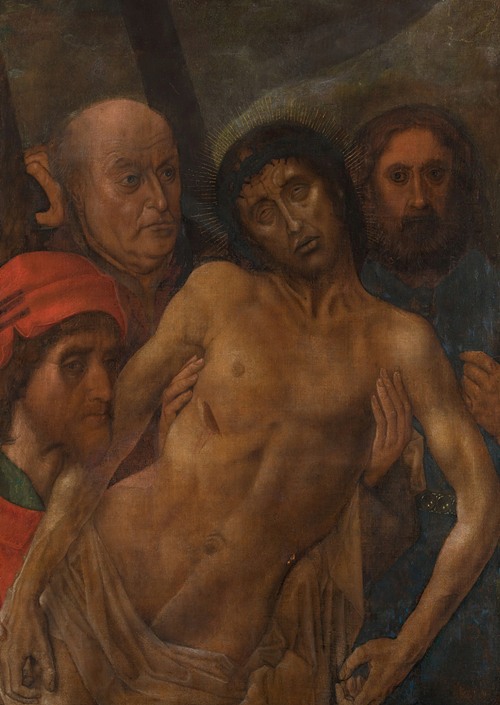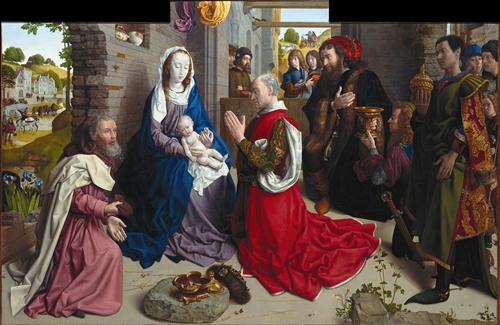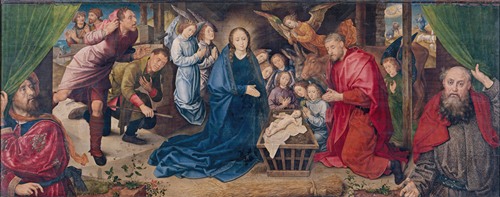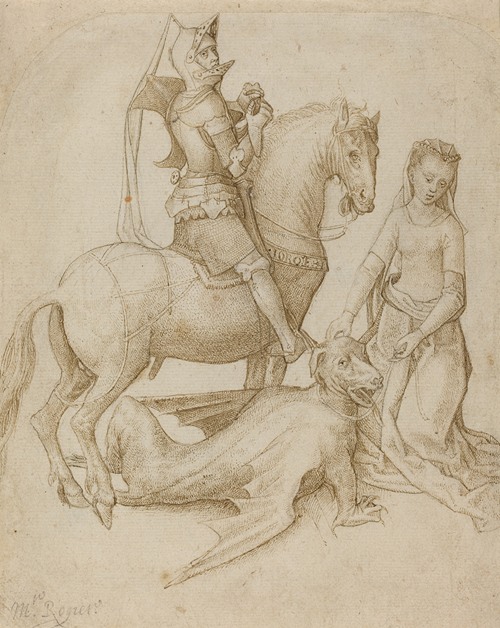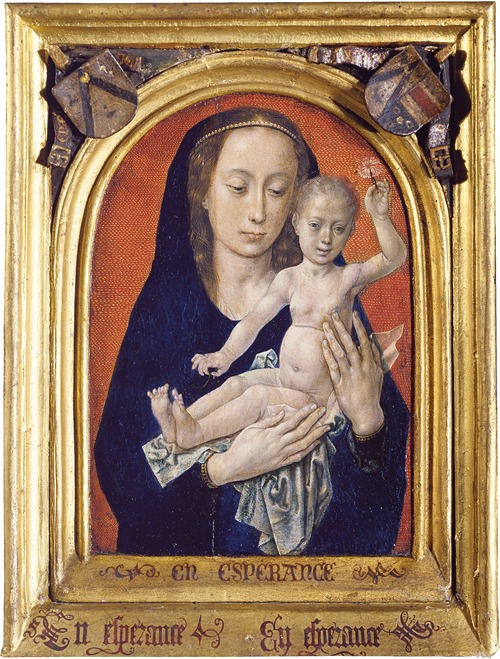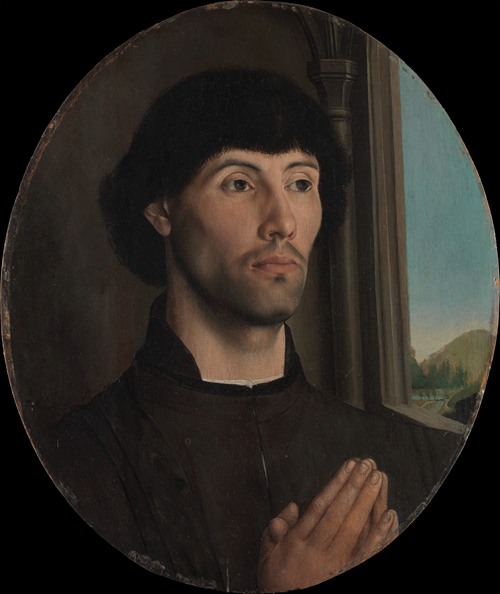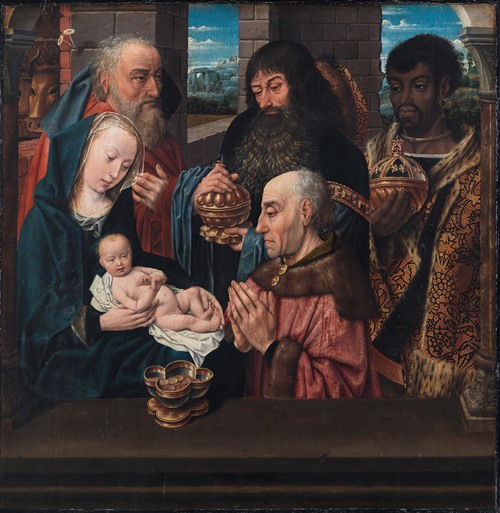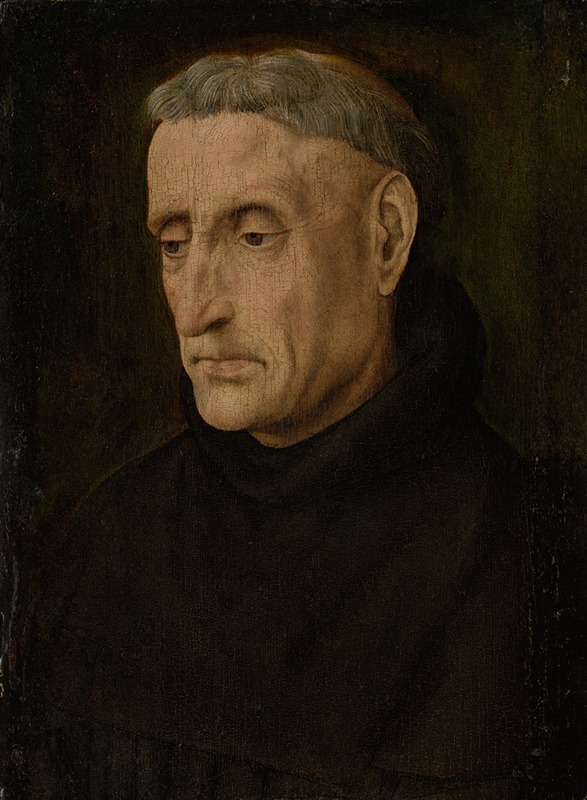
Hugo van der Goes was one of the most significant and original Flemish painters of the late 15th century. Van der Goes was an important painter of altarpieces as well as portraits. He introduced important innovations in painting through his monumental style, use of a specific colour range and individualistic manner of portraiture. From 1483 onwards, the presence of his masterpiece, the Portinari Triptych, in Florence played a role in the development of realism and the use of colour in Italian Renaissance art.
Hugo van der Goes was likely born in Ghent or in the vicinity of Ghent around the year 1440. Nothing is known with certainty about the artist's life prior to 1467, the year in which he became a master in the painters' guild of Ghent. The sponsors for his membership of the guild were Joos van Wassenhove, master painter in Ghent from 1464, and Daneel Ruthaert. It is likely that he had trained elsewhere before he became a master in Ghent. Some historians have suggested that Dieric Bouts was possibly the master of van der Goes but there is no independent evidence for this.
In 1468 the artist was commissioned by the city of Ghent to execute some works in connection with the grant of the Great Indulgence of the city. More commissions from the city in the following years required van der Goes to create decorations for events such as papal blazons. In 1468 he was in the town of Bruges making decorations to celebrate the marriage between Charles the Bold and Margaret of York. Hugo van der Goes is recorded again on 18 October 1468 when he and other members of Ghent's painter's guild hosted painters from nearby Tournai at the guild's assembly in Ghent to celebrate St. Luke's day together. St. Luke was the patron saint of painters.
In 1469 Hugo van der Goes and Joos van Wassenhove vouched for Alexander Bening for his entry as a master in the painter's guild of Ghent. Alexander Bening married Catherina van der Goes, a cousin of Hugo van der Goes, in 1480. The artist and his workshop worked on commissions of the city of Ghent to provide heraldic decorations for Charles the Bold's Joyous Entry in Ghent in 1469 and later in 1472.
When in 1470 Joos van Wassenhove left Ghent for Italy to become the court painter of Federico da Montefeltro, the Duke of Urbino, van der Goes became the leading painter in Ghent. In 1473 the Burgundian court paid van der Goes for creating the blazons used at Charles the Good's funeral. The painter was repeatedly elected as deacon of the painter's guild of Ghent and served as its deacon from 1474 to 1476.
It was during this period that Hugo van der Goes painted the Adoration of the Magi (also known as the Monforte Altarpiece (Gemäldegalerie, Berlin)) and worked on the commission of Tommaso Portinari for the Portinari Altarpiece (Uffizi, Florence), which arrived at its destination in Florence only in 1483, when the artist had already died.
Van der Goes achieved considerable success and secured important commissions from the Burgundian court, church institutions, affluent Flemish bourgeoisie and associations of Italian business people based in the Burgundian Netherlands. When he had reached the peak of his career in 1477 van der Goes suddenly decided to close down his workshop in Ghent to become a frater conversus (i.e. a lay brother) at the monastic community of the Rood Klooster (or Rooklooster) near Auderghem (now in Brussels). The Rood Klooster was part of the monastic wing of the Modern Devotion movement and belonged to the Windesheim Congregation. At the monastery he enjoyed certain privileges. He was allowed to continue working on painting commissions and to drink wine. According to the chronicle written up in Latin some time between 1509 and 1513 by Gaspar Ofhuys, a fellow monk in the Rood Klooster, van der Goes received visits by eminent persons including Archduke Maximillian.
During his time at the cloister he received in 1482 a request from the counsel of the City of Leuven to value the works for the Leuven city hall that Dieric Bouts had left unfinished at the time of his death. As a reward for this service van der Goes received a jug of Rhine wine from the city authorities. It is believed that it was van der Goes who completed Bouts' unfinished Triptych for Hyppolite Berthoz. His contribution was the painting on the left panel of the portraits of the couple who had paid for the tryptych. In 1482 the monastery sent van der Goes to Cologne together with his half-brother Nicolaes, who had also taken religious vows, and another brother of the monastery. On the return leg of this trip the artist suffered an acute depression and declared himself to be damned. He made an unsuccessful suicide attempt. His companions brought him back to Brussels and then to the Rood Klooster. After a brief recovery, he died not long thereafter in the Rood Klooster.
There is speculation that anxiety about his artistic achievements may have contributed to his madness, for 'he was deeply troubled by the thought of how he would ever finish the works of art he had to paint, and it was said then that nine years would scarcely suffice'. A report by a German physician, Hieronymus Münzer, from 1495, according to which a painter from Ghent was driven to melancholy by the attempt to equal the Ghent Altarpiece, may refer to Hugo van der Goes.
The mental breakdown of Hugo van der Goes was only rediscovered in 1863, when the Belgian historian Alphonse Wauters published the information, which he had found in Ofhuys' newly discovered chronicle. Wauters' publication inspired the late Romantic Belgian painter Emile Wauters (a nephew of Alphonse Wauters) to create his 1872 painting Portrait of Hugo van der Goes (1872, Royal Museums of Fine Arts of Belgium). This painting depicts Hugo van der Goes during his period of madness and was so successful that it was awarded a Grand Medal at the Paris salon. In 1873 the Dutch painter Vincent van Gogh mentioned Wauters' painting in a letter to his brother Theo van Gogh. On two further occasions van Gogh likened his own appearance to that of van der Goes as recreated by Wauters, and stated that he identified emotionally with the 15th-century painter.
